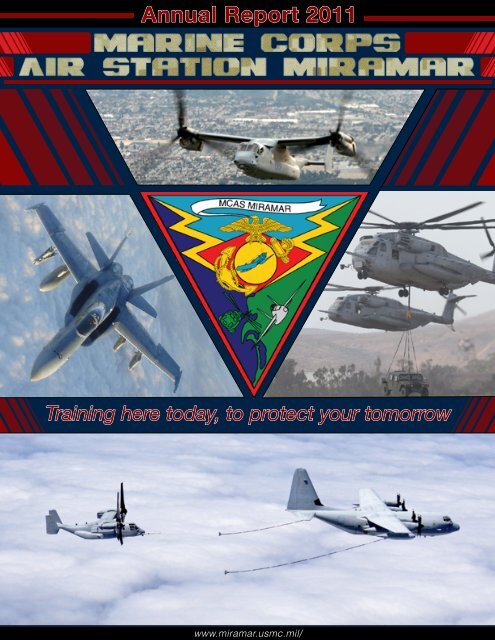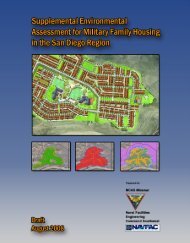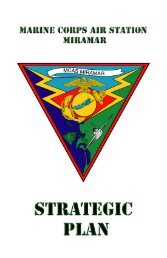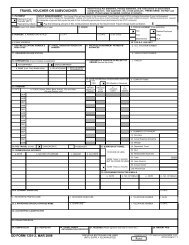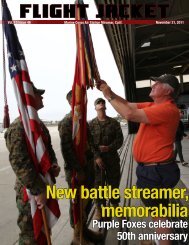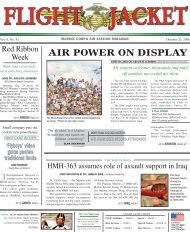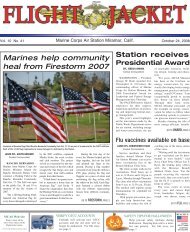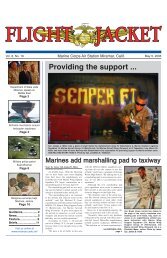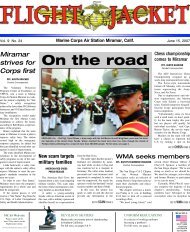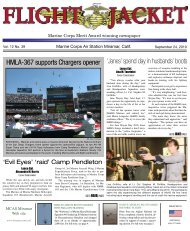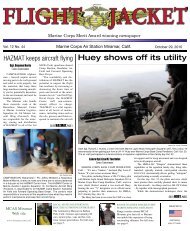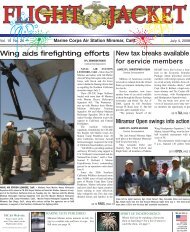Annual Report 2011 - Marine Corps Air Station Miramar
Annual Report 2011 - Marine Corps Air Station Miramar
Annual Report 2011 - Marine Corps Air Station Miramar
Create successful ePaper yourself
Turn your PDF publications into a flip-book with our unique Google optimized e-Paper software.
<strong>Annual</strong> <strong>Report</strong> <strong>2011</strong><br />
www.miramar.usmc.mil/<br />
Training here today, to protect your tomorrow
<strong>Annual</strong> <strong>Report</strong><br />
<strong>2011</strong><br />
Training Here Today,<br />
To Protect Your Tomorrow<br />
Table of Contents<br />
1<br />
Introduction from the Commanding Officer<br />
2<br />
<strong>Miramar</strong>: History in the Making<br />
4<br />
Operational Commands & Tenant Organizations<br />
6<br />
3rd <strong>Marine</strong> <strong>Air</strong>craft Wing<br />
8<br />
Strategic Location & Environmental Stewardship<br />
10<br />
Continuing to Build a Better <strong>Miramar</strong><br />
12<br />
Community Involvement<br />
16<br />
Facilities Improvements<br />
Commanding Officer<br />
Colonel Frank A. Richie<br />
Executive Officer<br />
Lieutenant Colonel Daniel F. Goodwin<br />
Sergeant Major<br />
Sergeant Major Bonnie L. Skinner<br />
<strong>Marine</strong> <strong>Corps</strong> <strong>Air</strong> <strong>Station</strong> <strong>Miramar</strong> is proud to be a vital member of the San Diego community. Over 15,000<br />
service members and their families, comprised of every branch of our military services, supported by civilian<br />
<strong>Marine</strong>s and contracted employees call “America’s Finest City” their home. We take great pride in<br />
being members of the San Diego community and look forward to this partnership continuing for many years to come.<br />
<strong>Marine</strong>s and Sailors from the 3rd <strong>Marine</strong> <strong>Air</strong>craft Wing continue to deploy throughout the world in support of the<br />
United States’ contingency operations. “In any clime and place,” these outstanding young men and women proudly<br />
serve their country and defend our nation’s freedom. Their dedication to duty, and the many sacrifices they willingly<br />
make while serving thousands of miles away from home, leave a lasting impression on all those who come in<br />
contact with them.<br />
MCAS <strong>Miramar</strong>’s strategic location and mission are essential elements in the preparation of these young <strong>Marine</strong>s<br />
and Sailors for combat. MCAS <strong>Miramar</strong> is located in the center of a constellation of <strong>Marine</strong> and Navy installations<br />
and ranges in the Southwestern United States. This ideal location allows for unimpeded access to the training<br />
needed to succeed in combat. The <strong>Marine</strong> <strong>Corps</strong> prides itself in being ready when the nation needs us, and our ability<br />
to train and the lethality of the <strong>Marine</strong> <strong>Air</strong> Ground Task Force’s air combat power must never be compromised.<br />
This annual report outlines MCAS <strong>Miramar</strong>’s structure<br />
and capabilities and explains the <strong>Marine</strong> <strong>Corps</strong>’ expeditionary<br />
warfighting philosophy. It also outlines the air<br />
station’s community involvement, how we work with<br />
local government agencies on land use compatibility issues,<br />
and how we take great pride in our stewardship<br />
of the environment with which we are entrusted. This<br />
report includes the air station’s economic contributions<br />
to the community and also includes an update on the<br />
major construction projects and quality of life initiatives<br />
we are implementing for our service members and their<br />
families.<br />
The San Diego community’s unwavering support of<br />
MCAS <strong>Miramar</strong> and all those who serve here is evident<br />
in the many contributions made to our warriors over this<br />
past year. Your support is never taken for granted and is<br />
always greatly appreciated.<br />
Thank you very much and Semper Fidelis!<br />
MCAS <strong>Miramar</strong> Commanding Officer<br />
Colonel Frank A. Richie<br />
Frank A. Richie<br />
Colonel, U.S. <strong>Marine</strong> <strong>Corps</strong><br />
Commanding Officer<br />
<strong>Marine</strong> <strong>Corps</strong> <strong>Air</strong> <strong>Station</strong> <strong>Miramar</strong><br />
MCAS <strong>Miramar</strong> <strong>Annual</strong> <strong>Report</strong> <strong>2011</strong><br />
1
In 1846 during the Mexican-American<br />
War, a detachment of <strong>Marine</strong>s<br />
from the second-class Sloop-of-War<br />
Cyane landed in San Diego to raise<br />
the American flag above what is now<br />
called Old Town.<br />
As a result of the war, the U.S. acquired<br />
San Diego and the rest of California, as<br />
well as Nevada, Utah, Arizona, and New<br />
Mexico, thus creating a nation from “sea<br />
to shining sea.”<br />
At that time, today’s <strong>Marine</strong> <strong>Corps</strong><br />
<strong>Air</strong> <strong>Station</strong> <strong>Miramar</strong> was part of a ranch<br />
owned by Don Santiago Arguello. Arguello’s<br />
cattle grazed on the mesa now covered<br />
with aircraft runways.<br />
After the American Civil War, Arguello<br />
divided his land and sold it in portions.<br />
In 1890, newspaper publisher Edward<br />
Scripps purchased one of these portions.<br />
Credited with naming <strong>Miramar</strong> – which<br />
loosely translates to “a view of the sea”<br />
– Scripps established his own ranch on<br />
2,000 acres in the <strong>Miramar</strong> area. Scripps<br />
Ranch presently adjoins MCAS <strong>Miramar</strong>.<br />
Although both the Navy and Army<br />
had established facilities on North Island<br />
in 1912, <strong>Miramar</strong>’s military history<br />
didn’t begin until 1917, when the Army<br />
purchased the <strong>Miramar</strong> area and created<br />
Camp Kearny, named for Gen. Stephen<br />
Kearny, whose Army of the West had<br />
<strong>Marine</strong> <strong>Corps</strong> <strong>Air</strong> <strong>Station</strong> <strong>Miramar</strong><br />
captured California during the Mexican-<br />
American War.<br />
The 13,000-acre base cost $4.5 million,<br />
and housed 1,200 buildings before it<br />
closed just five years later. <strong>Miramar</strong> languished<br />
for 10 years before being put to<br />
use again.<br />
Later, the abandoned parade field of<br />
Camp Kearny (East <strong>Miramar</strong>) was ideally<br />
located for the tricky flight practices of<br />
Charles Lindbergh. From San Diego, he<br />
took off for St. Louis, New York and Paris<br />
in his custom-made aircraft, The Spirit of<br />
St. Louis, which destined him for international<br />
fame.<br />
In 1932 a mooring mast and hangar<br />
were built at the camp for the U.S. Navy’s<br />
785-foot dirigibles the USS Akron and<br />
Macon. When the Navy gave up the airship<br />
program, Kearny Mesa was quiet<br />
once again.<br />
By the time World War II had broken<br />
out in Europe, <strong>Miramar</strong> was already undergoing<br />
a precautionary renovation.<br />
Camp Holcomb (renamed Camp Elliot)<br />
was built on part of Camp Kearny to<br />
be used for <strong>Marine</strong> artillery and machine<br />
gun training. Extending across more than<br />
26,000 acres, Camp Elliot became home<br />
to the Fleet <strong>Marine</strong> Force Training Center,<br />
West Coast and the 2nd <strong>Marine</strong> Division.<br />
Runways were constructed in 1940<br />
and the 1st <strong>Marine</strong> <strong>Air</strong>craft Wing arrived<br />
on Dec. 21 of that year. In August 1942<br />
the Wing was moved to Guadalcanal and<br />
the Navy commissioned Naval Auxiliary<br />
<strong>Air</strong> <strong>Station</strong> (NAAS) Camp Kearny in February<br />
1943.<br />
A month later the <strong>Marine</strong>s established<br />
<strong>Marine</strong> <strong>Corps</strong> <strong>Air</strong> Depot<br />
Camp Kearny, later renamed <strong>Marine</strong><br />
<strong>Corps</strong> <strong>Air</strong> Depot <strong>Miramar</strong> to avoid<br />
History<br />
confusion.<br />
During the 1940s, both the Navy and the <strong>Marine</strong> <strong>Corps</strong><br />
occupied <strong>Miramar</strong>. East <strong>Miramar</strong> (Camp Elliot) was used<br />
to train <strong>Marine</strong> artillery and armored personnel, while Navy<br />
and <strong>Marine</strong> <strong>Corps</strong> pilots trained on the western side, across<br />
Interstate 15.<br />
In 1945, the bases were combined and designated <strong>Marine</strong><br />
<strong>Corps</strong> <strong>Air</strong> <strong>Station</strong> <strong>Miramar</strong>.<br />
In 1947 the <strong>Marine</strong>s moved to El Toro in Orange County<br />
and <strong>Miramar</strong> was re-designated as a Naval Auxiliary <strong>Air</strong><br />
<strong>Station</strong>.<br />
In 1969, the Navy established the Top Gun school, immortalized<br />
in the 1985 movie of the same name, to train pilots<br />
in dog-fighting and fleet air defense during the Vietnam<br />
War.<br />
In 1993, the Base Realignment and Closure Committee<br />
recommended closing El Toro and Tustin air stations and<br />
moving the <strong>Marine</strong>s to <strong>Miramar</strong>. Top Gun and the Navy’s<br />
F-14 Tomcat squadrons were relocated, and the base was<br />
again re-designated <strong>Marine</strong> <strong>Corps</strong> <strong>Air</strong> <strong>Station</strong> <strong>Miramar</strong>.<br />
<strong>Marine</strong>s arrived in August 1994, and by 1 October 1997<br />
MCAS <strong>Miramar</strong> was fully operational.<br />
In 2006 <strong>Marine</strong> <strong>Corps</strong> <strong>Air</strong> Bases Western Area transitioned<br />
to <strong>Marine</strong> <strong>Corps</strong> Installations West, which is comprised<br />
of seven <strong>Marine</strong> <strong>Corps</strong> bases and installations in the<br />
Southwestern United States, including MCAS <strong>Miramar</strong>.<br />
MCI West provides the installation and training infrastructure<br />
to enable <strong>Marine</strong> <strong>Corps</strong> air and ground forces to develop<br />
and sustain operational readiness.<br />
Today, MCAS <strong>Miramar</strong> serves as home to the 3rd <strong>Marine</strong><br />
<strong>Air</strong>craft Wing, including <strong>Marine</strong> <strong>Air</strong>craft Group 11’s<br />
fixed wing F/A-18 Hornet and KC-130J Hercules squadrons,<br />
<strong>Marine</strong> <strong>Air</strong>craft Group 16’s CH-46E Sea Knight,<br />
CH-53E Super Stallion squadrons and a <strong>Marine</strong> Medium<br />
Tiltrotor MV-22 Osprey squadron.<br />
The support commands, <strong>Marine</strong> Wing Support Group 37<br />
and <strong>Marine</strong> <strong>Air</strong> Control Group 38, and the 3rd MAW Band<br />
are also located here.<br />
After an absence of 50 years, MCAS <strong>Miramar</strong> is once<br />
again the home of the <strong>Marine</strong> <strong>Corps</strong>’ West Coast air power.<br />
2 MCAS <strong>Miramar</strong> <strong>Annual</strong> <strong>Report</strong> <strong>2011</strong><br />
MCAS <strong>Miramar</strong> <strong>Annual</strong> <strong>Report</strong> <strong>2011</strong> 3
Operational Commands and Tenant Organizations<br />
Naval Aviation Survival Training Center <strong>Miramar</strong> - The<br />
staff of the ASTC provides aviation physiology and water survival<br />
training to aeronautically designated personnel in the<br />
Navy, <strong>Marine</strong> <strong>Corps</strong>, and Coast Guard and other military and<br />
government members.<br />
As a member of the Naval Survival Training Institute, the<br />
center is responsible for providing mission-oriented didactic<br />
and dynamic instruction including training in aeromedical aspects<br />
of flight, water survival and the proper use of the Aviation<br />
Life Support System.<br />
The ASTC also provides underwater egress training to <strong>Marine</strong><br />
ground forces and Navy frequent flyers. The center trains<br />
approximately 5,000 students in 11 different courses through<br />
more than 200 classes annually.<br />
Headquarters and Headquarters Squadron - The<br />
approximately 1,200 <strong>Marine</strong>s and 50 sailors who<br />
comprise Headquarters and Headquarters Squadron<br />
are responsible for the day-to-day operations<br />
of the air station. Their efforts ensure the 3rd <strong>Marine</strong> <strong>Air</strong>craft<br />
Wing has an optimal installation from which to train and deploy<br />
air combat support when the nation calls.<br />
4th MAW Site Support - Site Support transitioned from <strong>Marine</strong><br />
<strong>Air</strong>craft Group 46 and continued to develop command relationships<br />
with its active-duty counterparts and higher headquarters<br />
as ADCON units were activated and de-activated in<br />
the support of the Global War on Terrorism.<br />
Site Support was able to achieve unprecedented levels of<br />
combat readiness, success and “Esprit de <strong>Corps</strong>” thanks to<br />
headquarters staff, most who have previously deployed in support<br />
of Operation Iraqi Freedom, Operation Enduring Freedom<br />
and the Horn of Africa. Site Support functions as a consolidated<br />
administration department for all <strong>Marine</strong> <strong>Corps</strong> Reserve<br />
units stationed at MCAS <strong>Miramar</strong>.<br />
Reserve Support Unit - The RSU facilitates and coordinates<br />
the peacetime training of local <strong>Marine</strong> reservists as well as the<br />
mobilization and demobilization of <strong>Marine</strong> reservists during<br />
wartime operations.<br />
Through their efforts, the personnel of the Reserve Support<br />
Unit enhance the air station’s capability to prepare the <strong>Marine</strong><br />
<strong>Corps</strong> Reserve for the augmentation to and reinforcement of<br />
operational forces.<br />
4th Tank Battalion - Headquartered across the interstate, just<br />
a mile from MCAS <strong>Miramar</strong>’s main facilities, is the 4th Tank<br />
Battalion of the 4th <strong>Marine</strong> Division. A reserve command, 4th<br />
Tank Battalion is a self-sustaining unit capable of performing<br />
all tasks of a regular, active-duty <strong>Marine</strong> tank battalion.<br />
The battalion provides armored combat power for the division<br />
during amphibious assault and subsequent operations. The<br />
battalion also provides individual <strong>Marine</strong>s and combat-ready<br />
companies to augment and reinforce active-duty components<br />
when needed.<br />
Similar to their counterparts within <strong>Marine</strong> <strong>Air</strong>craft Group<br />
46, the battalion is also actively involved in community relations<br />
outreach programs, to include Toys for Tots.<br />
Combat Logistics Company 11 - The company provides support<br />
to 3rd <strong>Marine</strong> <strong>Air</strong>craft Wing and MCAS <strong>Miramar</strong> in the<br />
form of intermediate maintenance for motor transportation for<br />
all support squadrons; third echelon maintenance for utilities,<br />
bulk fuel and water, and small arms; providing float parts for<br />
units aboard the air station, and augmenting medical personnel<br />
at the branch medical clinic.<br />
The company also provides additional personnel to support<br />
day-to-day operations at the air station through the fleet assistance<br />
program.<br />
Naval Consolidated Brig <strong>Miramar</strong> - The Naval Consolidated<br />
Brig <strong>Miramar</strong> serves as the Pacific area regional confinement<br />
facility for the Department of Defense. It is one of only two<br />
Naval consolidated brigs.<br />
Built in 1989 and expanded in 2010, the 307,000 squarefoot<br />
facility can house a total of 600 male and female prisoners<br />
at one time.<br />
Branch Medical and Dental Clinics - More than 300 sailors<br />
and a team of civilians tend to the medical and dental needs of<br />
personnel stationed at <strong>Miramar</strong>. The branch medical clinic includes<br />
a sick call for non-emergency medical care and sections<br />
dedicated to women’s health, optometry, immunizations, and<br />
physical therapy, among others. The installation also features<br />
a full-service pharmacy and a family medical clinic.<br />
MCAS <strong>Miramar</strong>’s dental clinic staff, approximately 60<br />
Sailors from the 13th Dental Company headquartered at Camp<br />
Pendleton, Calif., tends to the dental health of all personnel<br />
assigned to the installation.<br />
Sports Medicine and Rehabilitation Team Clinic - The<br />
SMART Clinic was opened to help <strong>Marine</strong>s and sailors recover<br />
from injuries faster after sustaining a musculoskeletal<br />
injury.<br />
The SMART physicians at the clinic help <strong>Marine</strong>s and sailors,<br />
using the same approach as if they were professional athletes.<br />
They have more than 100 years of sports medicine experience<br />
combined, with many of them assisting at the Olympic,<br />
professional and college sport levels.<br />
<strong>Miramar</strong> Fire Department - To meet the MCAS <strong>Miramar</strong><br />
mission and to promote a safe environment, the <strong>Miramar</strong> Fire<br />
Department provides an extensive range of public safety services<br />
including fire prevention, public education, response to<br />
fire, medical and other types of emergency incidents and disaster<br />
mitigation.<br />
The department operates three engine companies and two<br />
medic-ambulance from two stations with a staff of 55 personnel.<br />
Though housed on station, the <strong>Miramar</strong> Fire Department<br />
not only responds to emergencies on station but also in the<br />
surrounding San Diego communities.<br />
4 MCAS <strong>Miramar</strong> <strong>Annual</strong> <strong>Report</strong> <strong>2011</strong><br />
MCAS <strong>Miramar</strong> <strong>Annual</strong> <strong>Report</strong> <strong>2011</strong> 5
3rd<br />
<strong>Marine</strong><br />
<strong>Air</strong>craft<br />
Wing<br />
Combat Wing<br />
The 3rd <strong>Marine</strong> <strong>Air</strong>craft<br />
Wing is the aviation<br />
combat element of the<br />
I <strong>Marine</strong> Expeditionary Force<br />
which is based at <strong>Marine</strong> <strong>Corps</strong><br />
Base Camp Pendleton, Calif.<br />
3rd MAW, headquartered at<br />
MCAS <strong>Miramar</strong>, conducts air operations<br />
in support of the MEF to<br />
include offensive air support, antiair<br />
warfare, assault support, aerial<br />
reconnaissance, electronic warfare,<br />
and control of aircraft and missiles.<br />
The following 3rd MAW<br />
squadrons are located at MCAS<br />
<strong>Miramar</strong>:<br />
<strong>Marine</strong> <strong>Air</strong>craft Group 11<br />
<strong>Marine</strong> All-Weather Fighter Attack Squadron 121<br />
<strong>Marine</strong> All-Weather Fighter Attack Squadron 225<br />
<strong>Marine</strong> Fighter Attack Training Squadron 101<br />
<strong>Marine</strong> Fighter Attack Squadron 232<br />
<strong>Marine</strong> Fighter Attack Squadron 314<br />
<strong>Marine</strong> Fighter Attack Squadron 323<br />
<strong>Marine</strong> Aerial Refueler Transport Squadron 352<br />
<strong>Marine</strong> Aviation Logistics Squadron 11<br />
<strong>Marine</strong> <strong>Marine</strong>s and sailors with<br />
squadrons from the 3rd<br />
<strong>Marine</strong> <strong>Air</strong>craft Wing<br />
continue to deploy in support<br />
of Operation Enduring Freedom<br />
and other overseas contingency<br />
operations.<br />
In 2008, the majority of 3rd<br />
MAW units that deployed headed<br />
to Al Asad in support of Operation<br />
Iraqi Freedom.<br />
When forward, the Wing<br />
provides close air support for<br />
convoys, casualty evacuations,<br />
and air transportation of troops<br />
and supplies vital to the success<br />
of coalition forces on the ground.<br />
The Wing’s fast response<br />
capabilities often take them<br />
outside of their immediate area of<br />
responsibility as they are asked<br />
to perform cordon and search<br />
missions to locate anti-coalition<br />
forces and high-value targets.<br />
The highly-trained and battletested<br />
<strong>Marine</strong>s and sailors have<br />
distinguished themselves in some<br />
of Iraq and Afghanistan’s most<br />
dangerous areas.<br />
3rd MAW has provided<br />
squadrons and detachments to the<br />
1st <strong>Marine</strong> <strong>Air</strong>craft Wing Unit<br />
Deployment Program, maintained<br />
a forward presence as part of<br />
<strong>Marine</strong> Expeditionary Units,<br />
provided support to Operation<br />
Enduring Freedom in Afghanistan,<br />
as well as supported relief efforts<br />
in Japan and anti-piracy efforts in<br />
Africa.<br />
<strong>Marine</strong> Medium Tiltrotor Squadron 161<br />
<strong>Marine</strong> Medium Tiltrotor Squadron 163<br />
<strong>Marine</strong> Medium Tiltrotor Squadron 165<br />
<strong>Marine</strong> Medium Tiltrotor Squadron 166<br />
<strong>Marine</strong> Medium Tiltrotor Squadron 561<br />
<strong>Marine</strong> Heavy Helicopter Squadron 361<br />
<strong>Marine</strong> Heavy Helicopter Squadron 462<br />
<strong>Marine</strong> Heavy Helicopter Squadron 465<br />
<strong>Marine</strong> Heavy Helicopter Squadron 466<br />
<strong>Marine</strong> Aviation Logistics Squadron 16<br />
Wing Headquarters Squadron 3<br />
M<br />
arine <strong>Air</strong>craft Group 16<br />
1st <strong>Marine</strong> Division<br />
Ground Combat Element<br />
I <strong>Marine</strong> Expeditionary Force<br />
Command Element<br />
3rd <strong>Marine</strong> <strong>Air</strong>craft Wing<br />
<strong>Air</strong>-Combat Element<br />
1st <strong>Marine</strong> Logistics Group<br />
Combat Support Element<br />
<strong>Marine</strong> <strong>Air</strong> Control Group 38<br />
<strong>Marine</strong> Tactical <strong>Air</strong> Command Squadron 38<br />
<strong>Marine</strong> Wing Communications Squadron 38<br />
<strong>Marine</strong> Wing Support Group 37<br />
<strong>Marine</strong> Wing Support Squadron 373<br />
6 MCAS <strong>Miramar</strong> <strong>Annual</strong> <strong>Report</strong> <strong>2011</strong><br />
MCAS <strong>Miramar</strong> <strong>Annual</strong> <strong>Report</strong> <strong>2011</strong> 7
Strategic Location, Training, and Economic<br />
Impacts of MCAS <strong>Miramar</strong><br />
Strategic location<br />
The expeditionary<br />
mission of the Navy and<br />
<strong>Marine</strong> <strong>Corps</strong> team requires<br />
strategic co-location in order<br />
to maintain the flexibility required<br />
for national security<br />
needs.<br />
MCAS <strong>Miramar</strong> is centrally<br />
located near more than 10<br />
West Coast Navy and <strong>Marine</strong><br />
<strong>Corps</strong> installations.<br />
Sixty-seven percent of<br />
continental United States Department<br />
of Defense training<br />
ranges are located in three<br />
southwestern states – California,<br />
Arizona and Nevada.<br />
MCAS <strong>Miramar</strong> is ideally<br />
positioned to maximize training<br />
dollars and prepare U.S.<br />
Armed Forces for operational<br />
commitments.<br />
Training at MCAS <strong>Miramar</strong><br />
In addition to being uniquely<br />
positioned to support the<br />
Navy and <strong>Marine</strong> <strong>Corps</strong> team<br />
on the West Coast, MCAS <strong>Miramar</strong><br />
is home to several stateof-the-art<br />
training facilities.<br />
Many of these facilities are<br />
used not only to train military<br />
personnel, but are shared facilities<br />
used in training local<br />
law enforcement personnel<br />
and personnel from other federal,<br />
county, and city agencies.<br />
The majority of MCAS <strong>Miramar</strong>’s<br />
training facilities are<br />
located aboard East <strong>Miramar</strong>.<br />
For the military, this approximately<br />
15,000 acre spread of<br />
hilly, chaparral desert is the<br />
location of five small-arms<br />
ranges, a nuclear, biological,<br />
and chemical training facility,<br />
and an aircraft fire rescue<br />
training site.<br />
The land itself supports<br />
training in land navigation,<br />
convoy operations, and related<br />
ground training exercises.<br />
The Army and the Army<br />
National Guard, Navy, <strong>Marine</strong><br />
reserve units, and ROTC units<br />
frequently use the land and<br />
facilities at East <strong>Miramar</strong> for<br />
training.<br />
The San Diego Sheriff’s<br />
Department has three small<br />
arms firing ranges aboard East<br />
<strong>Miramar</strong> as well as a canine<br />
training facility.<br />
<strong>Miramar</strong> Rifle and Pistol Range<br />
In 2002, MCAS <strong>Miramar</strong> officially opened the first automated<br />
rifle range in the <strong>Marine</strong> <strong>Corps</strong>.<br />
The range, named Hathcock Range Complex after Gunnery<br />
Sgt. Carlos N. Hathcock – a <strong>Marine</strong> sniper whose<br />
actions in Vietnam earned him legend status – employs<br />
state of the art computer systems to train <strong>Marine</strong>s in rifle<br />
marksmanship skills.<br />
Two key differences between Hathcock Range and other<br />
<strong>Marine</strong> <strong>Corps</strong> rifle ranges are the use of electronic shot<br />
marking and scoring, and the absence of pulling targets<br />
and shooters moving yard lines.<br />
A computerized system known as LOMAH runs the<br />
mechanized rifle range and can detect rounds hitting targets<br />
with a very small margin of error.<br />
The range features the only static firing line in the <strong>Marine</strong><br />
<strong>Corps</strong> and as shooters don’t have to pull and mark<br />
targets or move from their firing points, the course of fire<br />
takes significantly less time to complete.<br />
The new pistol range opened Jan. 9, 2007 and sits next<br />
to the rifle range. It consists of 25 targets and three firing<br />
lines.<br />
Economic Impacts<br />
Department of Defense spending in the San Diego region<br />
directly accounted for $16.1 billion worth of economic<br />
activity and directly employed more than 136,729<br />
people according to an Economic Impact Study conducted<br />
in 2009 by the San Diego Military Advisory Council.<br />
Additionally, the annual MCAS <strong>Miramar</strong> <strong>Air</strong>show,<br />
which draws more than 500,000 visitors, results in a direct<br />
and indirect economic impact of more than $17 million.<br />
8<br />
MCAS <strong>Miramar</strong> <strong>Annual</strong> <strong>Report</strong> <strong>2011</strong><br />
MCAS <strong>Miramar</strong> <strong>Annual</strong> <strong>Report</strong> <strong>2011</strong><br />
9
Environmental Stewardship<br />
Environmental Stewardship<br />
<strong>Marine</strong> <strong>Corps</strong> <strong>Air</strong> <strong>Station</strong> <strong>Miramar</strong><br />
continues to responsibly care<br />
for the environment through proactive programs<br />
that ensure the proper balance between<br />
the operational needs of the <strong>Marine</strong><br />
<strong>Corps</strong> and the protection and preservation<br />
of the environment for future generations.<br />
The air station’s environmental stewardship<br />
is carried out by the Environmental<br />
Management Department, which consists<br />
of an environmental engineering division, a<br />
program support division, a waste management<br />
division and a natural resource division.<br />
MCAS <strong>Miramar</strong>’s several pollution prevention<br />
initiatives highlight the air station’s<br />
aggressive pollution prevention and source<br />
reduction efforts.<br />
Through training and continuous research<br />
and education, the environmental<br />
engineering division takes responsibility<br />
for air quality, installation restoration, storage<br />
tanks, storm and wastewater, and spill<br />
prevention control and countermeasures.<br />
MCAS <strong>Miramar</strong> also works to improve<br />
water quality from storm-water runoff associated<br />
with industrial activity at the air<br />
station.<br />
The natural resources division addresses<br />
the conservation and management of soils,<br />
vegetated landscapes, wildlife and cultural<br />
resources in support of air station activities.<br />
These management principles are identified<br />
in the Integrated Natural Resources<br />
Management Plan to ensure regulatory<br />
compliance and conservation. This plan can<br />
be viewed on the Natural Resources/Regulatory<br />
program page at www/miramarems.<br />
com.<br />
A comprehensive waste management<br />
program coordinates solid waste, hazardous<br />
waste, pollution prevention and recycling<br />
efforts aboard MCAS <strong>Miramar</strong>.<br />
The landfill located on MCAS <strong>Miramar</strong><br />
is a potential source of renewable energy.<br />
When trash goes to the landfill, the methane<br />
it creates is harnessed and fed into an<br />
engine, which creates power.<br />
This technology could be used by the air<br />
station to increase energy and energy security<br />
and provide reliability and a backup in<br />
case the power goes out. Although the air<br />
station is currently not utilizing this technology,<br />
negotiations are being made to distribute<br />
some of the power onto the air station.<br />
By the end of fiscal year <strong>2011</strong>, recycling<br />
center personnel had collected and sold<br />
more than 699 tons of reusable materials.<br />
MCAS <strong>Miramar</strong> also received the 2008<br />
Presidential Award for Leadership in Federal<br />
Energy Management for exceeding<br />
the government mandated reduction levels.<br />
<strong>Miramar</strong> had the lowest energy intensity of<br />
all <strong>Marine</strong> <strong>Corps</strong> installations.<br />
When the Child, Youth and Teen Center<br />
aboard MCAS <strong>Miramar</strong> was built in 2010,<br />
special considerations were made to make<br />
it environmentally and energy efficient.<br />
Although the <strong>Marine</strong> <strong>Corps</strong> requires new<br />
buildings to achieve a Leadership in Energy<br />
and Environmental Design “Silver” rating,<br />
the Child, Youth and Teen Center strives for<br />
“Gold.”<br />
Through its use of artificial turf and reusable<br />
tires on the playground, a sustainable<br />
irrigation system, open architecture to help<br />
light come through and balanced air conditioning<br />
and heating systems, the center is<br />
friendly and energy efficient. The design<br />
also incorporates reusable, recycled materials<br />
from local sources in the community.<br />
A key element of the air station’s success in tending to the environment<br />
is the strong, supportive relationship the command has with area city, county<br />
and state governments.<br />
<strong>Air</strong> Installations Compatible Use Zones (AICUZ)<br />
Military installations and local government agencies with planning and<br />
zoning authority share the responsibilities for preserving land use compatibility<br />
near a military air installation.<br />
Through the MCAS <strong>Miramar</strong> <strong>Air</strong> Installation Compatible Use Zones<br />
Study, the command establishes guidelines and presents recommendations<br />
that ensure compatible land use planning within local jurisdictions affected<br />
by military aircraft operations.<br />
MCAS <strong>Miramar</strong>’s “<strong>Air</strong> Installations Compatible Use Zones” study of<br />
March 2005 was prepared to ensure compatible land use planning in surrounding<br />
communities affected by <strong>Miramar</strong>’s operations.<br />
The MCAS <strong>Miramar</strong> <strong>Air</strong>port Land Use Compatibility Plan (ALUCP) is<br />
the fundamental tool used by the San Diego County Regional <strong>Air</strong>port Authority,<br />
acting as the <strong>Air</strong>port Land Use Commission (ALUC), to safeguard<br />
the health and welfare of inhabitants in the vicinity of MCAS <strong>Miramar</strong> and<br />
the public in general.<br />
As required by California state law, the 2008 MCAS <strong>Miramar</strong> ALUCP<br />
is consistent with the safety and noise standards of the MCAS <strong>Miramar</strong> AI-<br />
CUZ document. Similar to the AICUZ, the ALUCP is used for the review<br />
of land use development proposals for compatibility issues and to ensure the<br />
orderly growth of communities surrounding MCAS <strong>Miramar</strong>.<br />
The land use recommendations and the MCAS <strong>Miramar</strong> ALUCP were<br />
formally adopted by the city of San Diego in October <strong>2011</strong>, and incorporated<br />
into the land development code.<br />
Copies are available at the public libraries of our neighboring communities<br />
as well as electronically through the “AICUZ” link on <strong>Marine</strong> <strong>Corps</strong> <strong>Air</strong><br />
<strong>Station</strong> <strong>Miramar</strong>’s website, www.miramar.usmc.mil.<br />
10 MCAS <strong>Miramar</strong> <strong>Annual</strong> <strong>Report</strong> <strong>2011</strong><br />
MCAS <strong>Miramar</strong> <strong>Annual</strong> <strong>Report</strong> <strong>2011</strong> 11
Community Involvement and <strong>Station</strong> Events<br />
MCAS <strong>Miramar</strong> hosts<br />
and supports a variety<br />
of community outreach<br />
events from fun-runs to base tours.<br />
These events give the community<br />
an opportunity to interact face-to-face<br />
with the service members of today’s<br />
volunteer military services.<br />
Volunteering<br />
Many <strong>Miramar</strong> volunteer programs<br />
offer <strong>Marine</strong>s and sailors the opportunity<br />
to donate their time, manpower<br />
and support to the neighboring communities.<br />
MCAS <strong>Miramar</strong> single service<br />
members and geo-bachelors contributed<br />
thousands of community service<br />
hours in <strong>2011</strong>.<br />
The Single <strong>Marine</strong> Program participated<br />
in a volunteer opportunity<br />
once a month throughout the year.<br />
These service members supported and<br />
volunteered for such efforts as the<br />
Challenge Horse Ranch, Otay Mesa<br />
Seeding Project, School Refurbishing<br />
aProject, Elementary and Junior High<br />
School Physical Education/Fitness<br />
Challenges, San Diego Yacht Club<br />
Wheelchair Regatta, MCAS <strong>Miramar</strong><br />
<strong>Air</strong> Show and MCCS Family Fall Festival.<br />
Partnership in Education<br />
Facilitated by the Installation<br />
School Liaisons, MCAS <strong>Miramar</strong><br />
maintains several Partnership in Education<br />
(PIE) agreements with neighboring<br />
schools within San Diego<br />
Unified School District. Under these<br />
partnerships, service members participate<br />
in a variety of activities that<br />
support and encourage improved student<br />
outcomes in schools that serve<br />
military K-12 students. <strong>Marine</strong>s and<br />
sailors support the program by sharing<br />
technical and leadership skills<br />
with the entire school community in<br />
activities such as tutoring, mentoring,<br />
Physical education Fitness Challenges,<br />
senior exhibitions, squadron tours<br />
and demonstrations, campus beautification<br />
projects and special events and<br />
festivals.<br />
Educators Workshop<br />
The Educators Workshop program<br />
offers another means of introducing<br />
the civilian community to the <strong>Marine</strong><br />
<strong>Corps</strong> and <strong>Marine</strong>s who fill its ranks.<br />
The program invites educators<br />
from states west of the Mississippi<br />
River to tour San Diego-area <strong>Marine</strong><br />
<strong>Corps</strong> bases and meet <strong>Marine</strong>s.<br />
Through the workshops, teachers,<br />
coaches, and school administrators<br />
are introduced to the <strong>Marine</strong> <strong>Corps</strong>.<br />
MCAS <strong>Miramar</strong> hosts approximately<br />
12 Educator’s Workshops annually.<br />
During the air station’s portion of<br />
the workshop, attendees visit the flight<br />
line where they get to view fixed and<br />
rotary-wing aircraft and the enlisted<br />
barracks as well as attend a question<br />
and answer session with <strong>Marine</strong>s from<br />
the air station.<br />
Tours<br />
Through community relations programs<br />
such as base tours, the air station provides<br />
the public another avenue by which they<br />
can see the <strong>Marine</strong> <strong>Corps</strong> up-close.<br />
The air station hosts tours for the public<br />
on a first-come, first-served basis as well<br />
as tours for large groups based on specific<br />
support requests and the availability of air<br />
station assets and personnel.<br />
Event Support<br />
MCAS <strong>Miramar</strong> also supports requests<br />
for aircraft fly-overs, static displays, and<br />
color guards for local community events<br />
and arranges for <strong>Marine</strong>s to serve as guest<br />
speakers and volunteers in the community.<br />
During fiscal year <strong>2011</strong>, MCAS <strong>Miramar</strong><br />
provided color guard support for various<br />
San Diego Chargers games and Veterans<br />
Day parades.<br />
Additionally, each year the air station<br />
facilitates support of several hundred media<br />
requests for information about the air<br />
station and its tenant organizations.<br />
<strong>Station</strong> Events<br />
While building relationships<br />
off base and bringing the<br />
civilian community on base to<br />
see the <strong>Marine</strong> <strong>Corps</strong> in action,<br />
the air station also supports<br />
base events designed<br />
to build morale and entertain<br />
the service members<br />
and their families.<br />
For example, in August<br />
<strong>2011</strong> MCAS <strong>Miramar</strong><br />
hosted a San Diego Chargers<br />
pre-season practice on<br />
the <strong>Miramar</strong> Youth and Teen<br />
Sports Complex.<br />
Also in <strong>2011</strong>, <strong>Miramar</strong> hosted its<br />
annual air show for the public and service<br />
members of San Diego and other<br />
surrounding areas.<br />
12<br />
MCAS <strong>Miramar</strong> <strong>Annual</strong> <strong>Report</strong> <strong>2011</strong><br />
MCAS <strong>Miramar</strong> <strong>Annual</strong> <strong>Report</strong> <strong>2011</strong><br />
13
The MCAS <strong>Miramar</strong> <strong>Air</strong> Show<br />
As an award-winning, world-class<br />
air show, the <strong>Miramar</strong> <strong>Air</strong> Show<br />
proves to be the highlight of the<br />
air station’s annual schedule of activities.<br />
The thrilling, three-day event draws crowds<br />
from around the world to come witness the<br />
finest in civilian and military aviation.<br />
The U.S. Navy’s Performance Demonstration<br />
Team, the Blue Angels headlined<br />
Sept. 30, Oct. 1 and 2, <strong>2011</strong>, air show with<br />
their six-jet exhibition of precise acrobatics<br />
and carefully choreographed maneuvers.<br />
Aside from the Blue Angels, the <strong>2011</strong><br />
<strong>Miramar</strong> <strong>Air</strong> Show featured the U.S. Army<br />
Golden Knights Parachute Team, a <strong>Marine</strong><br />
<strong>Air</strong>-Ground Task Force demonstration, and<br />
a twilight show ending with the recordbreaking<br />
Great Wall of Fire.<br />
General admission and parking are free<br />
for all attendees, but funds raised though<br />
premium seating and corporate sponsors<br />
go to quality of life projects and programs<br />
to further morale and welfare of service<br />
members and families assigned to the air<br />
station.<br />
14 MCAS <strong>Miramar</strong> <strong>Annual</strong> <strong>Report</strong> <strong>2011</strong><br />
MCAS <strong>Miramar</strong> <strong>Annual</strong> <strong>Report</strong> <strong>2011</strong> 15
Facilities Construction and Remodeling<br />
$27.4 million, these projects support the standup of the MV-<br />
22 Osprey at the air station. These airfield improvements<br />
continue our transition of Vietnam era helicopters to the latest<br />
tilt rotor technology. Improvements include construction<br />
of environmentally friendly fueling facilities and removal of<br />
older facilites. Other elements include apron modifications<br />
and the construction of a new wash facility.<br />
A key step for <strong>Miramar</strong> was the beginning of planning the<br />
<strong>Station</strong> Master Plan. Visioning workshops were conducted<br />
and collaborative effort initiated in the planning and development<br />
of <strong>Miramar</strong>’s Area Development Plans (ADPs) and<br />
Base Master Plan.<br />
Always striving for excellence,<br />
<strong>Marine</strong> <strong>Corps</strong> <strong>Air</strong><br />
<strong>Station</strong> <strong>Miramar</strong> continues<br />
to improve its services and facilities<br />
aboard the installation. During Fiscal<br />
Year <strong>2011</strong>, the air station made several<br />
improvements to both <strong>Marine</strong> <strong>Corps</strong><br />
Community Services and air station facilities.<br />
A wide variety of routine maintenance,<br />
repair and minor construction,<br />
occur at the air station. In <strong>2011</strong>, over<br />
$23 million was expended for these<br />
purposes. In addition, expenditures of<br />
over $5 million were made for similar<br />
larger actions. The total for continuing<br />
maintenance and repair in <strong>2011</strong> was<br />
over $28 million for primarily local<br />
businesses.<br />
Human Resource Service Center<br />
This 60,000 square foot office facility<br />
was awarded in September 2009.<br />
The $22.1 million project was completed<br />
in the summer of <strong>2011</strong>. When<br />
completed, this building consoldiated<br />
200 specialists from around the region<br />
as well as provided associated training<br />
spaces. Human Resource services for<br />
the entire Navy region will be improved<br />
by this co-location. All buildings being<br />
built on the air station use the guidelines<br />
of the U.S. Green Building Council’s<br />
LEED program, Leadership in Energy<br />
in Environmental Design.<br />
Consolidated Brig Expansion<br />
Awarded in September 2009 and<br />
completed in February of <strong>2011</strong>, this<br />
$30 million expansion provides facilities<br />
for an additional 200 residents.<br />
New <strong>Marine</strong> Combat Water Survival<br />
Training Facility<br />
Construction began in late September<br />
2009 of a new <strong>Marine</strong> Combat Water<br />
Survival Training Facility directly<br />
in front of the old pool. The project was<br />
constructed in two phases and completed<br />
in the summer of 2010.<br />
The project cost approximately $9<br />
million and upon completion will have<br />
an indoor classroom, bigger locker<br />
rooms and drying racks that the current<br />
pool does not offer.<br />
The new pool measures 50 meters<br />
long, 25 wide and 15 deep, conforming<br />
to <strong>Marine</strong> <strong>Corps</strong> standards. Eighty<br />
percent of the pool is covered by solar<br />
panels making it more energy efficient<br />
than the older pool which was<br />
demolished. The new building earned<br />
the prestigious Leadership in Energy<br />
and Enviromental Design certification<br />
and is the third LEED Gold building on<br />
<strong>Miramar</strong>.<br />
Recycled Water Irrigation System<br />
All twelve phases of the stationwide<br />
“Recycled Water” distribution<br />
system was completed in <strong>2011</strong> making<br />
MCAS <strong>Miramar</strong> one of the largest users<br />
of recycled water in the entire San<br />
Diego metropolitan area. The project<br />
brings recycled water to several ball<br />
fields, the physical fitness complex<br />
track field and chapel grounds.<br />
Military Working Dog Complex<br />
This $3.3 million K9 complex was<br />
completed in <strong>2011</strong>. The completed<br />
project provides kennels, offices, training<br />
yards and veterinary spaces.<br />
Fuel Pits and <strong>Air</strong>field Apron Modifications<br />
Awarded in December of 2010 for<br />
16<br />
MCAS <strong>Miramar</strong> <strong>Annual</strong> <strong>Report</strong> <strong>2011</strong> MCAS <strong>Miramar</strong> <strong>Annual</strong> <strong>Report</strong> <strong>2011</strong> 17
Visit us Online at http://www.miramar.usmc.mil<br />
Visit the Flight Jacket Facebook Online at http://www.facebook.com/pages/The-Flight-Jacket/145198516874<br />
Visit the <strong>Air</strong> Show Facebook Online at http://www.facebook.com/pages/<strong>Miramar</strong>-<strong>Air</strong>-Show/120899829796<br />
MCAS <strong>Miramar</strong> <strong>Annual</strong> <strong>Report</strong> 2010


